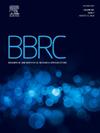Histone methyltransferase NSD modulates gene silencing mechanisms on Drosophila chromosome 4
IF 2.5
3区 生物学
Q3 BIOCHEMISTRY & MOLECULAR BIOLOGY
Biochemical and biophysical research communications
Pub Date : 2024-10-20
DOI:10.1016/j.bbrc.2024.150863
引用次数: 0
Abstract
The nuclear receptor-binding SET domain protein (NSD) gene family encodes histone methyltransferases that mono- and di-methylate lysine 36 on histone H3 (H3K36). Here, we examine the effects of NSD loss-of-function on transcription and heterochromatin formation in Drosophila to elucidate the role of NSD in chromatin structure regulation. Transcriptome analysis showed that NSD deletion activated more genes on chromosome 4, predominantly heterochromatic, than on other chromosomes. We further analyzed the position-effect variegation of fly eyes due to mini-white (mw+) transgenes inserted at various chromosomal loci and found that NSD deletion promoted mw+ transgene expression on chromosome 4. Additionally, NSD deletion reduced the binding of heterochromatin markers HP1a and H3K9 to chromosome 4. These findings suggest that NSD deletion disrupts chromosome 4 heterochromatin structure by reducing HP1a binding, implying NSD's role as an epigenetic regulator of chromosome 4 silencing.
组蛋白甲基转移酶 NSD 可调节果蝇 4 号染色体上的基因沉默机制。
核受体结合 SET 结构域蛋白(NSD)基因家族编码组蛋白甲基转移酶,可对组蛋白 H3(H3K36)上的赖氨酸 36 进行单甲基化和双甲基化。在这里,我们研究了 NSD 功能缺失对果蝇转录和异染色质形成的影响,以阐明 NSD 在染色质结构调控中的作用。转录组分析表明,与其他染色体相比,NSD缺失激活了以异染色质为主的4号染色体上更多的基因。我们进一步分析了插入不同染色体位点的迷你白色(mw+)转基因导致的蝇眼位置效应变异,发现NSD缺失促进了4号染色体上mw+转基因的表达。此外,NSD缺失减少了异染色质标记HP1a和H3K9与4号染色体的结合。这些发现表明,NSD缺失通过减少HP1a的结合破坏了4号染色体的异染色质结构,这意味着NSD是4号染色体沉默的表观遗传调节因子。
本文章由计算机程序翻译,如有差异,请以英文原文为准。
求助全文
约1分钟内获得全文
求助全文
来源期刊
CiteScore
6.10
自引率
0.00%
发文量
1400
审稿时长
14 days
期刊介绍:
Biochemical and Biophysical Research Communications is the premier international journal devoted to the very rapid dissemination of timely and significant experimental results in diverse fields of biological research. The development of the "Breakthroughs and Views" section brings the minireview format to the journal, and issues often contain collections of special interest manuscripts. BBRC is published weekly (52 issues/year).Research Areas now include: Biochemistry; biophysics; cell biology; developmental biology; immunology
; molecular biology; neurobiology; plant biology and proteomics

 求助内容:
求助内容: 应助结果提醒方式:
应助结果提醒方式:


